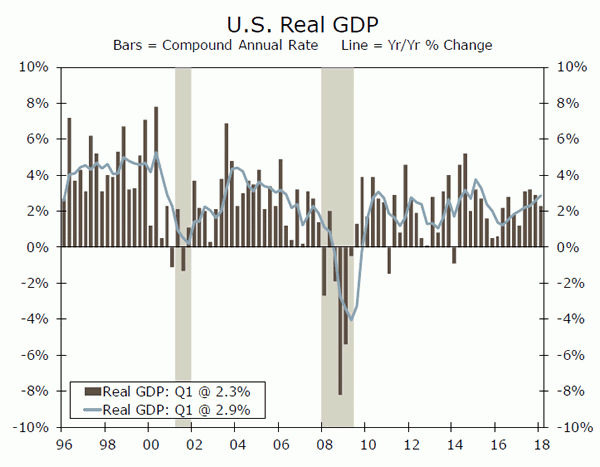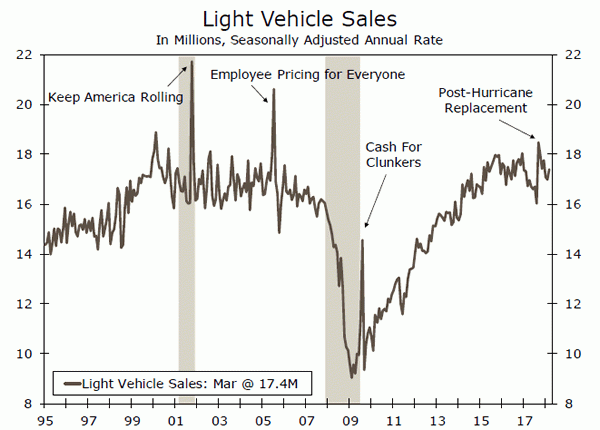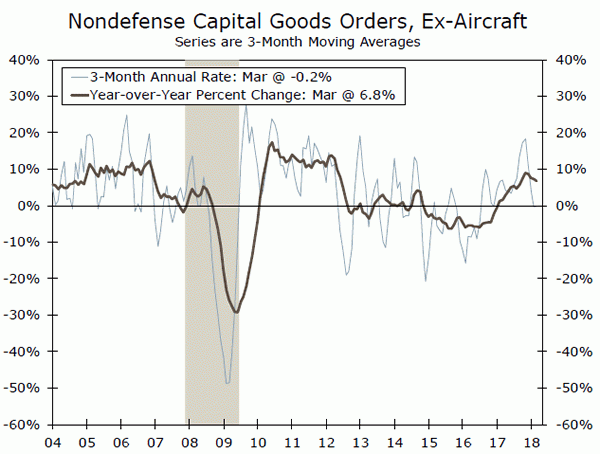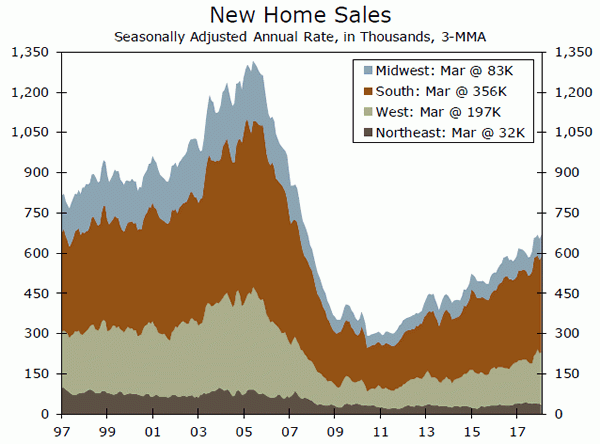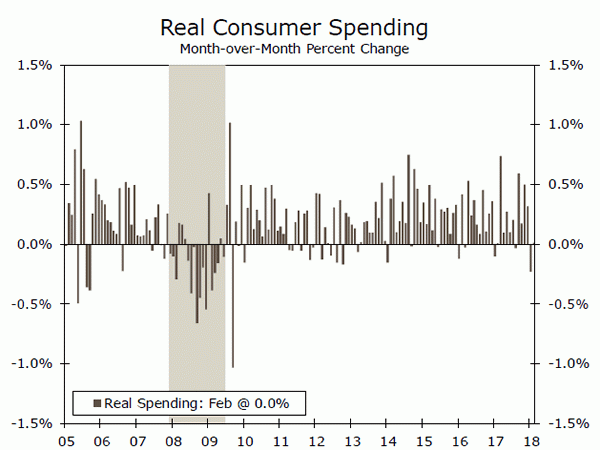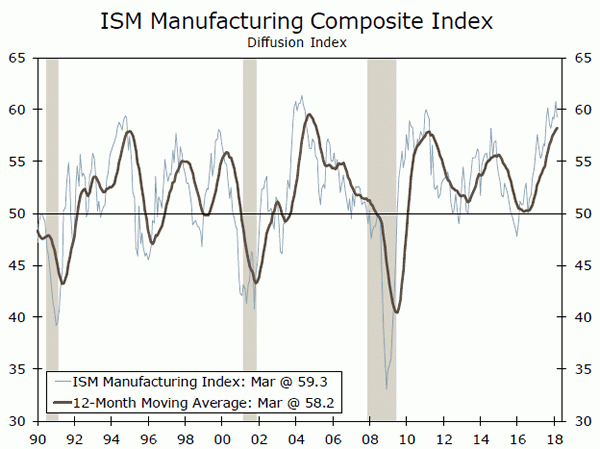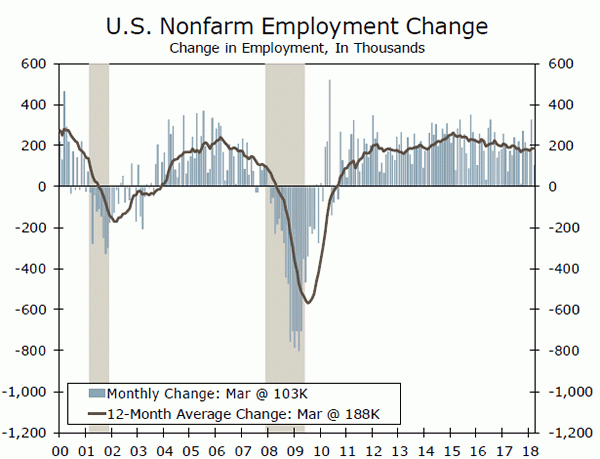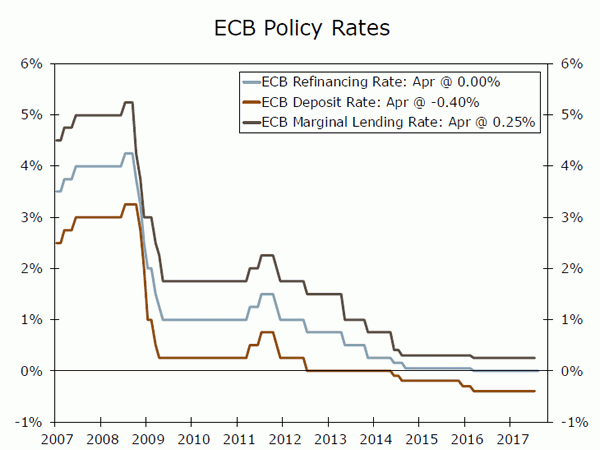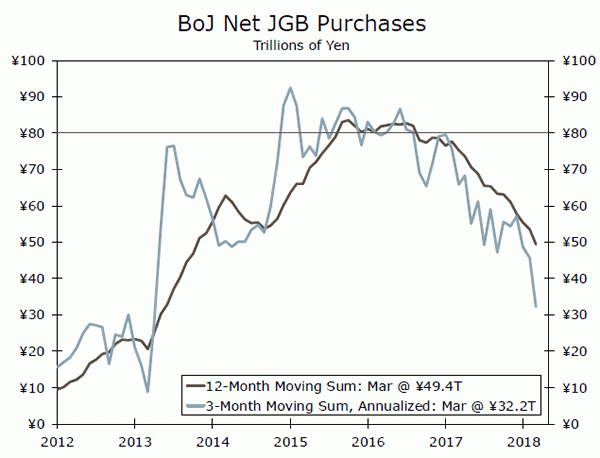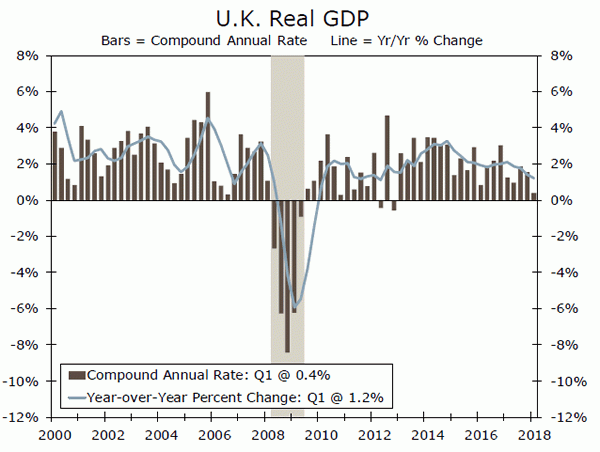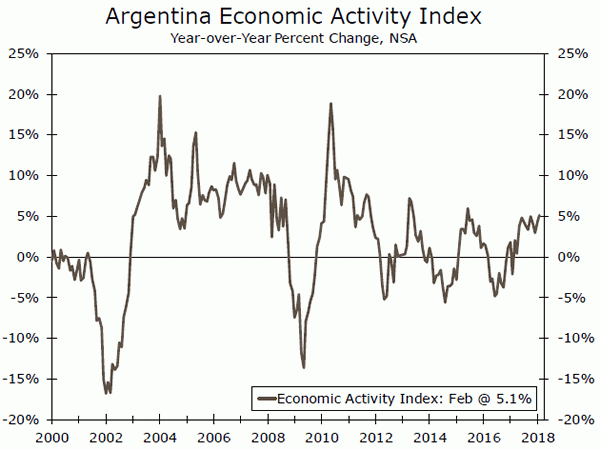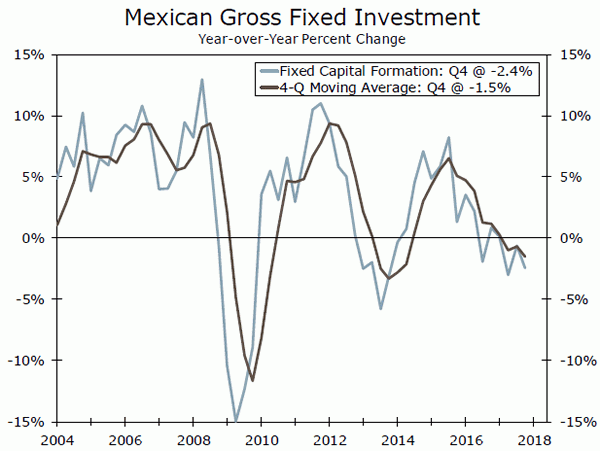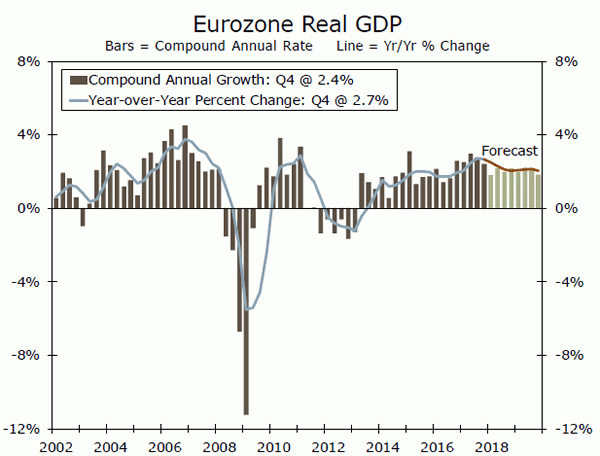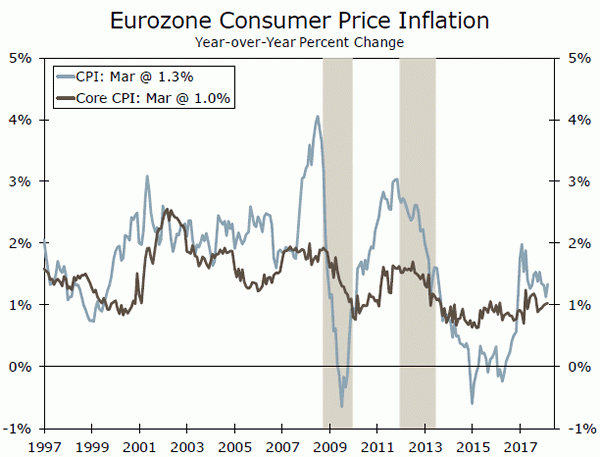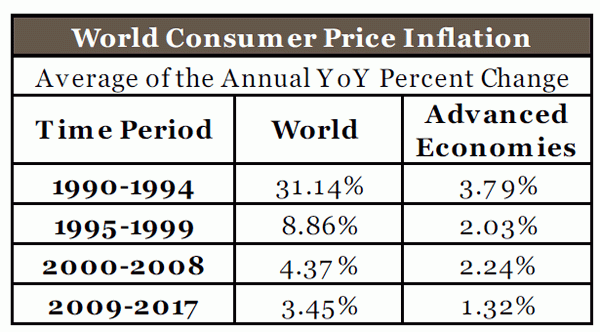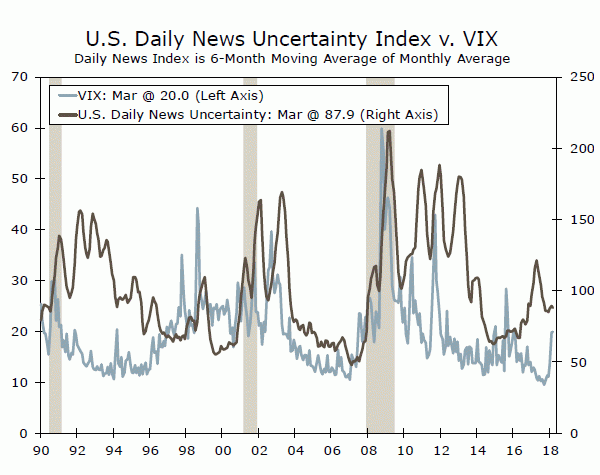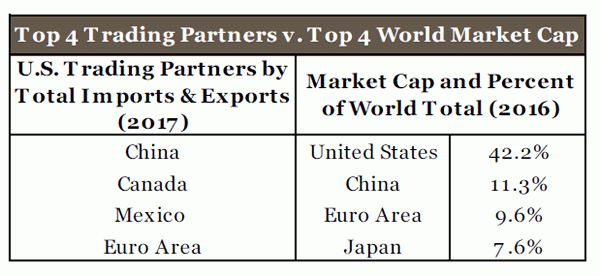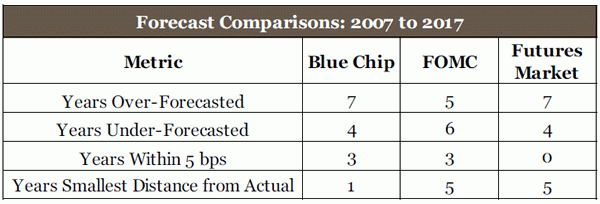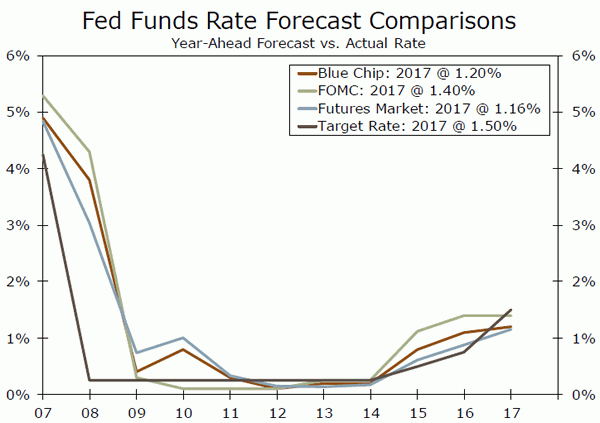U.S. Review
Better Off the Blocks in 2018
- First quarter GDP growth came in at an annualized rate of 2.3 percent. While that represents a slowing from the roughly 3 percent pace in the prior three quarters, the outturn was better than the 2.0 percent growth that had been expected.
- Low expectations for Q1 GDP may have to do with data quirks, which have been blamed for crummy first quarter growth in three out of the past four years.
- Elsewhere this week, the latest readings for new home sales and consumer confidence both came in better than expected.
Motor Vehicles Get Pulled Over
Real GDP growth slowed in the first quarter to an annualized pace of 2.3 percent. One key reason for the slower growth rate was that consumer spending grew at just a 1.1 percent annualized clip. That is the slowest pace in more than four and a half years. What happened to surging consumer confidence and tax cuts?
Admittedly, the 4.0 percent growth rate in the final quarter of 2017 was a tough act to follow. Some of the Q4 strength in consumer spending had to do with revved-up auto sales after hurricanerelated flooding resulted in replacement spending at the time. Outlays for motor vehicles added 0.45 percentage points to Q4 growth and subtracted 0.42 percentage points from Q1.
We are not worried about the consumer. We learned this week that consumer confidence rose to 128.7—the second-highest level reached for this bellwether since 2000. Similarly, the unemployment rate, which presently is 4.1 percent, has not been so low since 2000. In fact, we are just a few ticks away from 3.8 percent, the cycle low in 2000. To find a lower unemployment rate, you need to go back to the 1960s. While participation is not what it used to be, it stands to reason that the job market is presently in good enough shape to sustain further growth in consumer spending.
Durables Report Offered Last-Minute Preview for GDP
Double-digit percentage gains in orders for both civilian and defense aircraft lifted overall durable goods orders to a betterthan- expected monthly increase of 2.6 percent. But elsewhere, orders were flat in March when you exclude the volatile transportation sector. Despite sustained high levels for ISM new orders, actual orders remain inconsistent.
Core capital goods shipments tend to be a good indicator for equipment spending, and that offered a last minute preview for the equipment line in Friday’s GDP report, as this series posted a three-month annualized growth rate of just 4.1 percent. The equipment spending line in the GDP report was 4.7 percent.
The notion that the soft patch in capital spending might only be delayed is sullied by the fact that core capital goods orders fell in March, and the three-month annualized rate is in negative territory. We have been forecasting a moderation in the pace of capital spending despite the tax cuts, and that forecast (regrettably) remains intact.
Although business spending on equipment slowed, spending on structures picked up. Nonresidential fixed investment spending grew at a 12.3 percent clip in Q1.
New Home Sales Picked up in March
March new home sales jumped 4.0 percent, which exceeded the 1.9 percent gain that had been expected. Not only that, the data for the prior month (February) were revised higher as well. The annualized pace of new home sales, now at 694K, represents the fastest pace of the current expansion. Weather still appears to be playing a factor. New home sales were down in the Northeast as realtors perhaps found it difficult to get potential buyers to look at listings in a month in which four nor’easters pummeled the region.
U.S. Outlook
Personal Spending • Monday
Personal spending grew only 0.2 percent in February. This matched January’s pace, but marked a significant downshift from breakneck growth rates registered in late 2017. Adjusting for inflation, expenditures were flat on the month. The consumer had been providing strong support to GDP growth, adding 2.75 percentage points to the headline in Q4-2017. However, the initial GDP estimate shows this contribution falling to 0.73 points in Q1. This suggests that March spending continued to be weak.
While spending has slowed, disposable income rose a strong 0.4 percent in February, boosted by tax cuts and rising wages. This helped push the saving rate up to 3.4 percent in February, after falling to a 12-year low of 2.4 percent in December. We expect another month of strong income growth for March. Given rising incomes and continued high levels of consumer confidence, we expect spending to pick back up as 2018 progresses.
Previous: 0.2% Wells Fargo: 0.3% Consensus: 0.4% (Month-over-Month)
ISM Manufacturing • Tuesday
The ISM manufacturing index came in at 59.3 in March, moderating from 60.8 in February. The decline was broad-based, with the indices for production, new orders and employment all falling. However, the ISM index remains strong, in-line with levels at the end of 2017 and consistent with an expanding manufacturing sector. Seventeen of 18 industries reported growth in March, led by fabricated metals, plastics and computer & electronic products.
The biggest concern for manufacturers from the March report was a jump in the prices paid index, to 78.1 from 74.2 in February. Fifty-seven percent of respondents reported paying higher prices. We will be watching the April report for signs that price pressures are continuing to build. Higher input costs have been helping to lift inflation, and we expect this trend to continue as resource constraints push prices up further.
Previous: 59.3 Wells Fargo: 58.5 Consensus: 58.5
Employment • Friday
Nonfarm payrolls rose 103,000 in March, below expectations. The three-month average gain remains at a solid 202,000 jobs, suggesting strong underlying momentum. Weather played a role in the lower March job gain; construction jobs–which are particularly sensitive to weather, like the storms in the Northeast–were down 15,000. A standout on the positive side was the manufacturing sector, where the three-month average job gain rose to 25,000. As the labor market continues to tighten, and the pool of workers on the sidelines shrinks, monthly job gains are likely to slow somewhat. We expect payrolls to have increased 195,000 in April.
Average hourly earnings grew 0.3 percent in March and are up 2.7 percent on the year. The gradual rise in earnings over the past six months has been helping to support income growth and inflation, but is also increasing pressure on profit margins. We expect another strong month for average hourly earnings in April.
Previous: 103,000 Wells Fargo: 195,000 Consensus: 185,000
Global Review
Developed Countries’ Central Banks: Staying the Course
- The European Central Bank (ECB) decided to leave interest rates unchanged while it kept its purchase of assets at €30 billion per month until at least September.
- The Bank of Japan (BoJ) kept its own monetary policy measures basically unchanged and is even further away than the ECB from any move to start unwinding its expansionary monetary policy.
- Economic growth in the U.K. downshifted in Q1 as it increased only 0.1 percent, not annualized. Before this release consensus expectations were for the Bank of England (BoE) to increase interest rates at its May 10 Monetary Policy Committee meeting. However, this seems unlikely now.
ECB and Bank of Japan Decisions as Expected
As expected, the European Central Bank (ECB), decided to leave interest rates unchanged while it kept its purchase of assets at €30 billion per month until at least September. Perhaps the biggest issue with the ECB’s decision was the fact that the latest economic data have been weaker-than-expected, so markets were anxious to hear the spin the ECB president put on the communication of the institution’s decision. To this, ECB President Mario Draghi said that he believed that the recent weaker-than-expected economic data were expected to be temporary and that he remained upbeat on the pace of economic growth for the Eurozone for the rest of the year. While the purchase of assets will probably run until September, we do not expect the ECB to start increasing rates until mid-2019. Meanwhile, the Bank of Japan (BoJ) kept its own monetary policy measures basically unchanged, as expected, and is even further away than the ECB from any move to start unwinding its expansionary monetary policy. The communication from the BoJ took away reference to the timing to get back to the target rate of inflation of 2 percent, which prompted speculation that the BoJ may be indicating a change in policy. However, (at the press conference), Governor Kuroda affirmed that the removal was not an indication of policy change.
U.K. Economic Growth Weakest Since 2012
Economic growth in the U.K. downshifted in Q1, as it increased 0.1 percent, not annualized. The outturn was lower than the 0.3 percent expected by markets and sent analysts to revise their view on the timing for when the Bank of England (BoE) may start tightening monetary policy. Economic growth in Q1 was driven by industrial production, up 0.7 percent, while services increased at a 0.3 percent rate, not annualized and compared to the previous quarter. However, much of the weakness was allocated to the construction sector, which nose-dived 3.3 percent in the quarter. Before this release, consensus expectations were for the BoE to increase interest rates at its May 10 Monetary Policy Committee meeting. However, this seems unlikely now. We still believe that the economy may have been affected, at least in part, by weatherrelated issues in Q1 and expect these temporary factors to ease in the coming quarters. However, the weakness in Q1 will raise questions on the underlying health of the British economy going forward.
Economic Activity in Argentina Mixed in February
In Argentina, the economic activity index showed mixed results, as it increased 5.1 percent compared to a year earlier, while declining 0.2 percent on a seasonally-adjusted basis compared to January. This was the first decline on a month-on-month basis since July 2017. Meanwhile, the strong year-over-year increase was due to a low base of comparison in February 2o17 for almost every sector of the economy. The index of economic activity in February 2017 declined 2.1 percent compared to February 2016. Meanwhile, the Macri administration has run into trouble with its planned increase in utility rates, threatening this year’s inflation target. At the same time, the Argentine central bank has needed to intervene in the foreign exchange rate market in an attempt to reduce the pressure on the Argentine peso.
Global Outlook
Mexico GDP • Monday
The Mexican economic environment proved challenging in 2017 amid increased inflation due to adjustments in regulated prices and the central bank’s monetary tightening campaign. Real GDP growth was just 1.5 percent year over year in Q4-2017, the slowest pace in four years. The contraction in gross fixed capital formation in Mexico suggests uncertainty is weighing on investment spending. NAFTA is perhaps the biggest uncertainty, but political uncertainty and the major corporate tax overhaul in the United States are likely also influencing investment decisions by Mexican firms.
Despite the challenges, domestic consumption managed to hold up at the end of the year, particularly for services. Faster economic growth in the United States should be a tailwind to economic growth in Mexico this year. We look for real GDP growth in Mexico to grow 1.9 percent this year, more or less in-line with its pace last year.
Previous: 1.5% Wells Fargo: 1.7% Consensus: 1.6% (Year-over-Year)
Eurozone GDP • Wednesday
Real GDP growth in the Eurozone in Q4-2017 was 2.7 percent yearover- year, the fastest pace since Q3-2007. In its policy report this week, the Governing Council of the European Central Bank (ECB) noted that favorable financing conditions and a robust labor market have been supportive to aggregate demand.
Some of the momentum at the end of last year appears to have faded slightly. Purchasing Manager Indices have moved lower since January, and industrial production growth was negative in the first two months of the year. Looking forward, ECB policymakers see the risks to the outlook as broadly balanced, while noting protectionism as a key downside risk. We look for real GDP in the Eurozone to decelerate in the coming quarters, but for actual growth to remain modestly above the potential growth of most countries in the Eurozone, which would continue to gradually narrow the output gap.
Previous: 2.7% Wells Fargo: 2.5% Consensus: 2.5% (Year-over-Year)
Eurozone CPI • Thursday
Despite a relatively positive growth outlook in the Eurozone, the lack of inflationary pressures have limited any sense of urgency by ECB policymakers to signal an end to its asset-purchase program. Core CPI inflation is just 1.0 percent year over year at present, well short of the “below, but close to, 2 percent inflation” the ECB targets. Not only has actual inflation remained in check, but inflation expectations based on market and survey-based measures “were largely unchanged since the January meeting,” according to the notes from the Governing Council meeting last week.
If inflation shows signs of picking up steam in April and May, the ECB would likely be more inclined to send strong signals at its June meeting about the end of quantitative easing. With the Federal Reserve actively winding down its balance sheet, stronger inflation in the Eurozone remains the final missing link to bring a decade of bond buying by the world’s two biggest central banks to a close.
Previous: 1.3% Wells Fargo: 1.4% Consensus: 1.3% (Year-over-Year)
Point of View
Interest Rate Watch
Interest Rates in a Global Context Two themes underlie our view on the interaction of global developments and domestic interest rates. First, the global marketplace allocates financial capital through global capital flows. Financial incentives matter.
Second, interest rates, exchange rates, economic growth and the flow of funds are part of the same economic system, even though research often splits the analysis of each of these areas among different analysts.
Global Inflation: Lower
Before we jump into the analysis of interest rates, our approach today is to start with the fundamentals—particularly inflation. As illustrated in the top table, inflation rates for both the world and advanced economies have slowed over the past thirty years and especially since the 2007-2008 recession.
Therefore, nominal interest rates would follow this lower path as well over the long run.
Short-Run Volatility
In contrast, over shorter periods of time, financial flows respond to changes in investor confidence. In the middle graph, we highlight a measure of daily news uncertainty as an illustration of the information that greets investors every day and how that uncertainty may lead to periods of risk aversion or risk seeking. For example, note the low level of uncertainty during the 2004-2007 period that was associated with risk-seeking behavior in both the equity and housing markets. In addition, note the high level of uncertainty associated with the 2010-2012 period, but the drop in risk aversion with equity market gains during the 2014-2016 period. It is interesting that the current market volatility would be associated with higher uncertainty indications.
Trade and Market Capitalization
Finally, notice the link between international trade relationships and allocations of financial capital as measured by market capitalization (bottom table). Finance and real economic activity are indeed linked.
Credit Market Insights
Loan Growth Revival?
Loan growth data, related to the commercial and industrial (C&I) space, have recently shown sign of a pick-up. Following nearly four years of slowing year-over-year growth, C&I loan growth appears to have reversed that pattern. Over the past four months, C&I loan growth has been strengthening, a trend we expect to continue, albeit at a restrained pace. This trend is consistent for both small and large domestic banks, as well as foreign banks.
The encouraging trend is not limited to just C&I lending, as commercial real estate lending appears to have hit an inflection point as well. Likewise, consumer loan growth has ticked up, a trend consistent with the Federal Reserve’s Senior Loan Officer Survey, which shows stronger levels of demand for these types of loans. Interestingly enough, banks continue to tighten lending standards to protect against potentially delinquent borrowers. Although net charge-off rates have slowly inched up over the past several months, the series is still near its all-time low.
The reversal of the decelerating year-overyear growth rates for loans is perhaps partially attributable to borrowers looking to lock in lower rates in an environment in which the FOMC is prepared to continue to tighten policy. The tax reform bill may have also stoked loan demand and encouraged businesses to focus on equipment and structural investment projects.
Topic of the Week
How Accurate Are Fed Funds Rate Forecasts?
The FOMC will meet next week for its May policy meeting. Although we do not look for any change to the fed funds rate next week, we take this opportunity to examine the accuracy of fed funds rate forecasts from popular forecasting sources. We highlight findings from our recent report “Forward Rates Part 2: Who is the Oracle,” as decision makers continue to watch the FOMC for insights on the path of the fed funds rate this year.
We use 11 years of historical forecast data from the Blue Chip Financial Forecasts, the FOMC and the fed funds futures market to compare the accuracy of three wellknown forecasting sources in predicting the fed funds rate from 2007 t0 2017. We take the year-ahead projected fed funds rate and compare it to the year-end actual fed funds rate for each forecast horizon. We found that the FOMC and futures market forecasts have the smallest distance from the actual rate in five of the 11 years, while the Blue Chip forecasts have the smallest distance in just one year (top table). In terms of direction, Blue Chip and the futures market over-predict the actual rate more than 60 percent of the time. The FOMC’s projections have a more balanced 5-6 split on over- and under-forecasting the actual rate, respectively. For more details on our methodology, see the report referenced above.
Our analysis also has implications for comparing public and private sector forecasts. Both private sector sources were similar in terms of over-forecasting the actual rate. However, the Blue Chip and FOMC forecasts come within 5 bps of the actual rate the same number of times, and the FOMC and futures market were tied for the number of years with the smallest distance from the actual rate. It is also interesting to note the more recent trend that all sources over-forecasted the actual rate in 2015 and 2016, yet under-forecasted the actual rate in 2017 as the FOMC picked up the pace of tightening (bottom chart). As market participants keep a close watch on expected rates from various forecast sources, it is key to remember that each source has tradeoffs when used as a benchmark for future rates.




